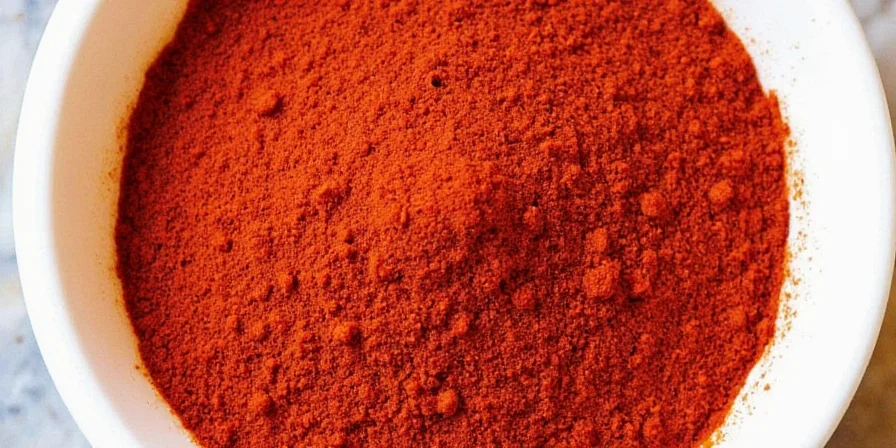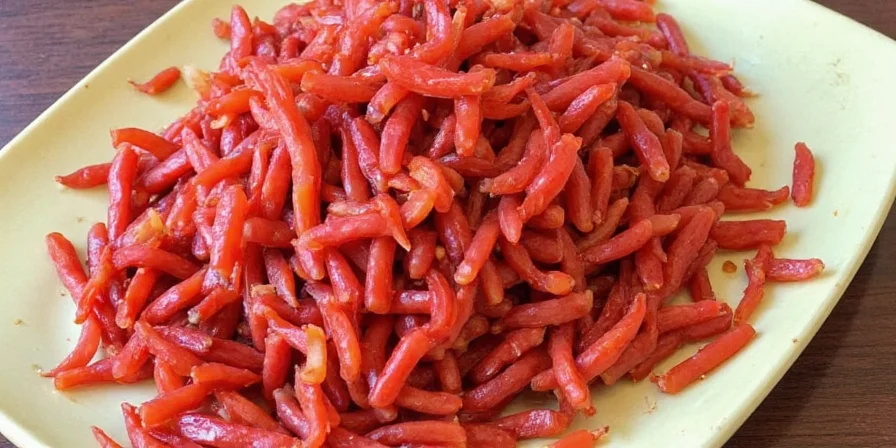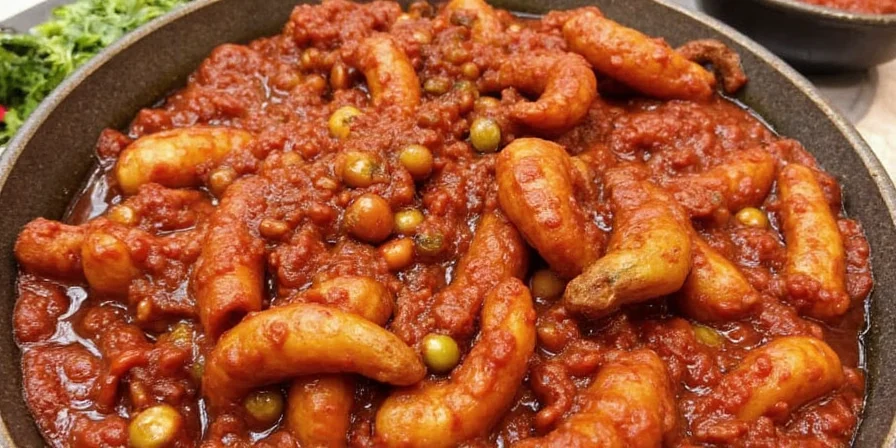Daxi Sichuan is a distinct regional variation of Sichuan cuisine originating from western Sichuan Province, characterized by its intensified ma la (numbing-spicy) profile that's 30-50% spicier than standard Sichuan cooking. Unlike mainstream Sichuan dishes that balance heat with subtlety, Daxi Sichuan amplifies both the numbing sensation from Sichuan peppercorns and the fiery heat from chilies, creating a more aggressive flavor profile developed historically to combat the region's mountainous climate and humidity. This guide provides authentic techniques to recreate Daxi Sichuan dishes at home with precise spice control.
Table of Contents
- What Is Daxi Sichuan? (Key Differences From Regular Sichuan)
- Spice Level Breakdown: Mild vs. Wild (Objective Heat Scale)
- The Essential 5-Spice Cabinet for Authentic Daxi Flavor
- 5 Pro Tips for Cooking Daxi Sichuan at Home (Avoid Common Mistakes)
- How to Balance the Heat: Professional Pairing Techniques
- Top 5 Must-Try Daxi Sichuan Dishes (With Authentic Recipes)
- Heat Safety: Don't Burn Your Tongue Off (Science-Backed Solutions)
- Debunking Common Daxi Sichuan Myths (What Chefs Won't Tell You)
- The Neuroscience of Ma La: Why Your Brain Craves the Burn
- Conclusion

What Is Daxi Sichuan? (Key Differences From Regular Sichuan)
Daxi Sichuan represents the western frontier of Sichuan Province's culinary tradition, distinguished by amplified ma la intensity. Unlike mainstream Sichuan cooking, this regional variant prioritizes extreme sensory contrast through higher concentrations of Sichuan peppercorns and dried chilies. Authentic Daxi preparations balance volcanic heat with subtle undertones of fermented beans and toasted spices, creating layered flavor experiences that evolve from first bite to finish.
Geographical isolation in western Sichuan's mountainous terrain shaped this style's development. Historically, chefs used increased spice levels for food preservation in humid climates while creating dishes that combat regional chill. This practical adaptation evolved into a celebrated culinary identity where heat serves functional purpose rather than mere shock value. Eastern Sichuan cuisine typically uses 15-20 dried chilies per dish, while authentic Daxi preparations employ 30-40 for the same serving size.

Spice Level Breakdown: Mild vs. Wild (Objective Heat Scale)
Understanding Daxi's heat spectrum prevents culinary misadventures. This objective scale clarifies intensity beyond subjective 'spicy' labels:
| Spice Level | Description | Heat Scale (out of 10) |
|---|---|---|
| Mild Daxi | Just a hint of heat with strong emphasis on flavor and fragrance | 3/10 |
| Medium Daxi | Pleasantly spicy, with a slight tongue tingle | 6/10 |
| Wildfire | For true spice warriors – expect numb lips and sweating brow | 9+/10 |
The Essential 5-Spice Cabinet for Authentic Daxi Flavor
Authentic Daxi cooking requires specific components working in concert. These elements form the non-negotiable foundation:
- Sichuan Peppercorn: High-altitude varieties deliver citrusy notes alongside signature numbness
- Dried Red Chilies: Facing Heaven chilies preferred for floral heat without bitterness
- Fermented Black Beans: Whole bean paste preserves texture complexity
- Garlic and Ginger: Freshly minced for aromatic brightness
- Chili Oil: Infused slowly with Sichuan peppercorns for balanced finish

5 Pro Tips for Cooking Daxi Sichuan at Home (Avoid Common Mistakes)
- Toast the Peppercorns First: Lightly dry toast them before grinding to enhance their floral, citrusy aroma.
- Don't Fry the Chili Oil Too Hot: High heat burns the chilies — aim for a slow infusion over medium-low heat.
- Add Liquids Last: To preserve the volatile oils in the spices, add broths or sauces after the spice base has been cooked.
- Balance with Sugar: Just a pinch can cut through the spiciness without making the dish sweet.
- Let It Rest: Flavors deepen after sitting for 10–15 minutes — don’t rush!
How to Balance the Heat: Professional Pairing Techniques
True Daxi mastery lies in strategic counterpoints that enhance rather than extinguish heat:
- Cooling Ingredients: Cucumber, tofu, and lettuce provide relief
- Starchy Relief: Rice or noodles absorb some heat and calm the palate
- Aromatic Enhancers: Scallions, cilantro, and toasted sesame seeds add contrast
- Acidity: A splash of vinegar or lime juice can brighten the dish

Top 5 Must-Try Daxi Sichuan Dishes (With Authentic Recipes)
These dishes exemplify Daxi's signature balance of aggression and refinement:
- Hong You Chao Shou – Red oil dumplings with a numbing, spicy kick
- Mapo Tofu – Silken tofu bathed in chili and bean paste, topped with minced pork
- Gan Bian Si Ji Dou – Crispy green beans tossed in a wicked chili-garlic sauce
- Kung Pao Chicken – Sweet, sour, and super spicy with peanuts for crunch
- Shui Zhu Beef – Tender beef slices swimming in a crimson sea of spice
Heat Safety: Don't Burn Your Tongue Off (Science-Backed Solutions)
Responsible heat management ensures enjoyable experiences:
- Milk or Yogurt: Dairy neutralizes capsaicin better than water
- Rice or Bread: Eat carbs to dilute the spice hit
- Wait It Out: Capsaicin doesn't last forever — patience helps
- Wear Gloves: When handling raw chilies, protect your skin

Debunking Common Daxi Sichuan Myths (What Chefs Won't Tell You)
Separating fact from fiction enhances authentic appreciation:
- Myth: All Sichuan Food Is the Same – Nope! Daxi Sichuan is more aggressive and uses more chili oil than standard Sichuan dishes.
- Myth: Spiciness Equals Quality – Wrong. Real Daxi chefs care more about flavor balance than pure heat.
- Myth: Numbness Comes from MSG – False! That tingling is all thanks to hydroxy-alpha-sanshool in Sichuan pepper.
The Neuroscience of Ma La: Why Your Brain Craves the Burn
Daxi's addictive quality stems from biological mechanisms. Capsaicin triggers pain receptors interpreted as heat, prompting endorphin release that creates euphoric relief. Simultaneously, Sichuan peppercorns' hydroxy-alpha-sanshool stimulates touch neurons at 50Hz frequency, generating the signature 'buzz'. This dual neurological response—pain followed by pleasure—rewires reward pathways, explaining why repeated exposure increases spice tolerance. Modern studies confirm this effect activates brain regions associated with thrill-seeking, transforming culinary challenge into compulsive craving.
Conclusion
Daxi Sichuan transcends mere cooking—it's a sensory journey rooted in geographical necessity and cultural adaptation. By understanding its spice architecture and neurological impact, home cooks gain confidence to experiment beyond preset heat levels. Start with Mild Daxi techniques, gradually incorporating Wildfire elements as your palate evolves. Remember: authentic heat serves flavor, not the reverse. Embrace the burn as your teacher, and you'll unlock dimensions of taste inaccessible to timid palates.
Frequently Asked Questions
How does Daxi Sichuan differ from standard Sichuan cuisine?
Daxi Sichuan originates specifically from western Sichuan's mountainous regions, featuring intensified ma la profiles with 30-50% more chili oil and toasted peppercorns. This adaptation combats humidity and cold, creating bolder flavor contrasts than eastern Sichuan variants which emphasize subtlety.
What's the safest way to adjust spice levels for beginners?
Start by reducing chili quantity by half while maintaining full Sichuan peppercorn measurement. The numbing sensation masks heat intensity, allowing gradual heat acclimation. Always toast peppercorns first—this unlocks floral notes that balance perceived spiciness without altering ingredient ratios.
Can I achieve authentic Daxi flavors without specialty ingredients?
While substitutions exist, true authenticity requires Sichuan peppercorns and Facing Heaven chilies. Seek reputable Asian grocers for red flower pepper (hong hua jiao) and Xiao Mi La chilies. Freeze-dried alternatives lose volatile oils essential for the ma la experience—fresh or sun-dried varieties are non-negotiable.
Why do Daxi dishes cause lip tingling that lasts longer than the heat?
The lingering buzz comes from sanshool's unique mechanism: it stimulates mechanoreceptors at specific frequencies (5-50Hz) that trigger prolonged neural signaling. Unlike capsaicin's temporary pain response, this tactile sensation persists as nerve pathways reset—typically 15-20 minutes post-consumption, signaling successful ma la execution.











 浙公网安备
33010002000092号
浙公网安备
33010002000092号 浙B2-20120091-4
浙B2-20120091-4